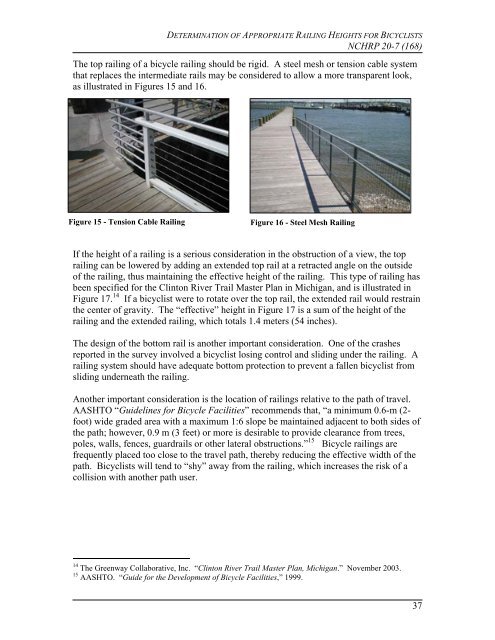Bicycle Railing Height Report - AASHTO - Subcommittee on Design
Bicycle Railing Height Report - AASHTO - Subcommittee on Design
Bicycle Railing Height Report - AASHTO - Subcommittee on Design
Create successful ePaper yourself
Turn your PDF publications into a flip-book with our unique Google optimized e-Paper software.
DETERMINATION OF APPROPRIATE RAILING HEIGHTS FOR BICYCLISTS<br />
NCHRP 20-7 (168)<br />
The top railing of a bicycle railing should be rigid. A steel mesh or tensi<strong>on</strong> cable system<br />
that replaces the intermediate rails may be c<strong>on</strong>sidered to allow a more transparent look,<br />
as illustrated in Figures 15 and 16.<br />
Figure 15 - Tensi<strong>on</strong> Cable <str<strong>on</strong>g>Railing</str<strong>on</strong>g><br />
Figure 16 - Steel Mesh <str<strong>on</strong>g>Railing</str<strong>on</strong>g><br />
If the height of a railing is a serious c<strong>on</strong>siderati<strong>on</strong> in the obstructi<strong>on</strong> of a view, the top<br />
railing can be lowered by adding an extended top rail at a retracted angle <strong>on</strong> the outside<br />
of the railing, thus maintaining the effective height of the railing. This type of railing has<br />
been specified for the Clint<strong>on</strong> River Trail Master Plan in Michigan, and is illustrated in<br />
Figure 17. 14 If a bicyclist were to rotate over the top rail, the extended rail would restrain<br />
the center of gravity. The “effective” height in Figure 17 is a sum of the height of the<br />
railing and the extended railing, which totals 1.4 meters (54 inches).<br />
The design of the bottom rail is another important c<strong>on</strong>siderati<strong>on</strong>. One of the crashes<br />
reported in the survey involved a bicyclist losing c<strong>on</strong>trol and sliding under the railing. A<br />
railing system should have adequate bottom protecti<strong>on</strong> to prevent a fallen bicyclist from<br />
sliding underneath the railing.<br />
Another important c<strong>on</strong>siderati<strong>on</strong> is the locati<strong>on</strong> of railings relative to the path of travel.<br />
<str<strong>on</strong>g>AASHTO</str<strong>on</strong>g> “Guidelines for <str<strong>on</strong>g>Bicycle</str<strong>on</strong>g> Facilities” recommends that, “a minimum 0.6-m (2-<br />
foot) wide graded area with a maximum 1:6 slope be maintained adjacent to both sides of<br />
the path; however, 0.9 m (3 feet) or more is desirable to provide clearance from trees,<br />
poles, walls, fences, guardrails or other lateral obstructi<strong>on</strong>s.” 15 <str<strong>on</strong>g>Bicycle</str<strong>on</strong>g> railings are<br />
frequently placed too close to the travel path, thereby reducing the effective width of the<br />
path. Bicyclists will tend to “shy” away from the railing, which increases the risk of a<br />
collisi<strong>on</strong> with another path user.<br />
14 The Greenway Collaborative, Inc. “Clint<strong>on</strong> River Trail Master Plan, Michigan.” November 2003.<br />
15 <str<strong>on</strong>g>AASHTO</str<strong>on</strong>g>. “Guide for the Development of <str<strong>on</strong>g>Bicycle</str<strong>on</strong>g> Facilities,” 1999.<br />
37


